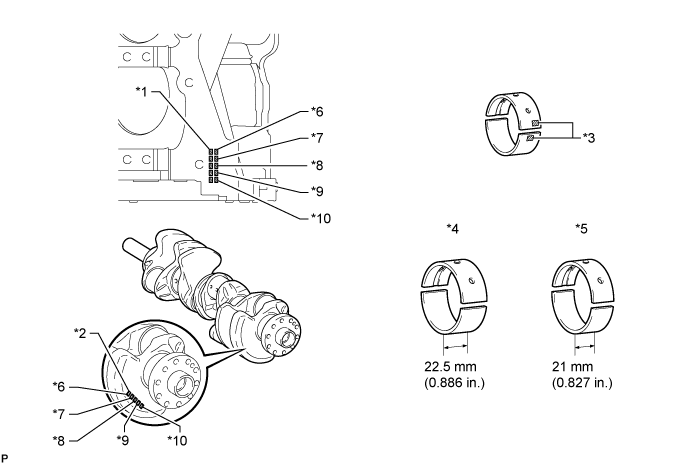Land Cruiser URJ200 URJ202 GRJ200 VDJ200 - 1UR-FE ENGINE MECHANICAL
CYLINDER BLOCK - INSPECTION
| 1. CLEAN CYLINDER BLOCK SUB-ASSEMBLY |
Using a gasket scraper, remove all the gasket material from the top surface of the cylinder block.
Using a soft brush and solvent, thoroughly clean the cylinder block.
- NOTICE:
- If the cylinder is washed at high temperatures, the cylinder liner sticks out beyond the cylinder block. Always wash the cylinder block at a temperature of 45°C (113°F) or less.
| 2. INSPECT CYLINDER BLOCK FOR WARPAGE |

Using a precision straightedge and feeler gauge, measure the warpage of the surfaces which contact the cylinder head gaskets.
- Maximum warpage:
- 0.07 mm (0.00276 in.)
If the warpage is more than the maximum, replace the cylinder block sub-assembly.
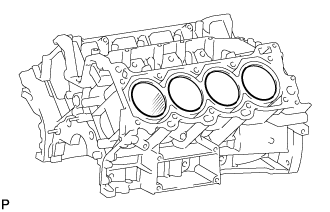
Visually check the cylinder for vertical scratches. If deep scratches are present, rebore all 8 cylinders.
If necessary, replace the cylinder block sub-assembly.
| 3. INSPECT CYLINDER BORE |
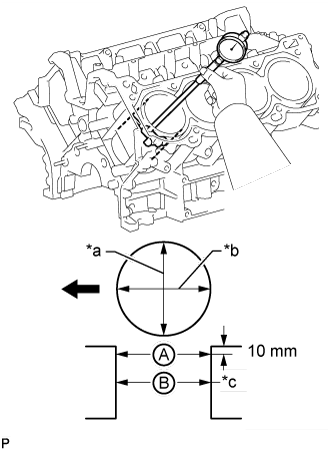
Using a cylinder gauge, measure the cylinder bore diameter at positions A and B in the thrust and axial directions.
- Measurement position (A):
- 10 mm (0.394 in.)
- Standard diameter:
- 94.000 to 94.012 mm (3.700 to 3.701 in.)
- Maximum diameter:
- 94.200 mm (3.709 in.)
| *a | Thrust Direction |
| *b | Axial Direction |
| *c | Center |
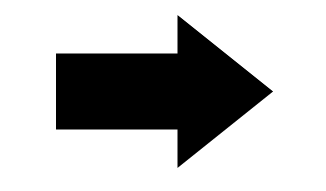 | Engine Front |
If the diameter is more than the maximum, replace the cylinder block sub-assembly.
| 4. INSPECT RING GROOVE CLEARANCE |
Using a feeler gauge, measure the clearance between a new piston ring and the wall of the ring groove.
- Standard Ring Groove Clearance:
Item Specified Condition No. 1 compression ring 0.020 to 0.070 mm (0.000787 to 0.00276 in.) No. 2 compression ring 0.020 to 0.060 mm (0.000787 to 0.00236 in.) Oil ring 0.070 to 0.145 mm (0.00276 to 0.00571 in.)
If the clearance is not as specified, replace the piston with pin sub-assembly.
| 5. INSPECT PISTON RING END GAP |
Insert the piston ring into the cylinder bore.
Using a piston, push the piston ring a little beyond the bottom of the ring travel, 60 mm (2.36 in.) from the top of the cylinder block.
Using a feeler gauge, measure the end gap.
- Standard End Gap (for Type A):
Item Specified Condition No. 1 compression ring 0.23 to 0.33 mm (0.00906 to 0.0130 in.) No. 2 compression ring 0.40 to 0.50 mm (0.0157 to 0.0197 in.) Oil ring 0.10 to 0.40 mm (0.00394 to 0.0157 in.)
- Standard End Gap (for Type B):
Item Specified Condition No. 1 compression ring 0.22 to 0.32 mm (0.00866 to 0.0126 in.) No. 2 compression ring 0.35 to 0.45 mm (0.0138 to 0.0177 in.) Oil ring 0.10 to 0.40 mm (0.00394 to 0.0157 in.)
- Maximum End Gap:
Item Specified Condition No. 1 Compression Ring 0.42 mm (0.0165 in.) No. 2 Compression Ring 0.55 mm (0.0217 in.) Oil Ring 0.45 mm (0.0177 in.)
- HINT:

- Type A and type B can be distinguished by the color of the paint marks or the cross-section shape of the No. 2 compression ring.
| Item | Paint Mark | |
| Type A | No. 1 compression ring | Blue |
| No. 2 compression ring | Orange | |
| Type B | No. 1 compression ring | Yellow |
| No. 2 compression ring | Green | |
| *1 | No. 2 Compression Ring |
| *a | Type A |
| *b | Type B |
If the end gap is more than the maximum, replace the piston ring. If the end gap is more than the maximum even with a new piston ring, replace the cylinder block sub-assembly.
| 6. INSPECT PISTON WITH PIN SUB-ASSEMBLY |
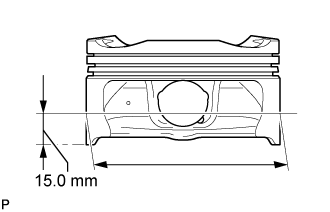
Using a micrometer, measure the piston diameter at a position that is 15.0 mm (0.591 in.) from the bottom of the piston (refer to the illustration).
- Standard diameter:
- 93.980 to 93.990 mm (3.7000 to 3.7004 in.)
- Minimum diameter:
- 93.815 mm (3.6935 in.)
If the diameter is less than the minimum, replace the piston with pin sub-assembly.
| 7. INSPECT PISTON OIL CLEARANCE |
Measure the cylinder bore diameter in the thrust direction.
Subtract the piston diameter measurement from the cylinder bore diameter measurement.
- Standard oil clearance:
- 0.010 to 0.032 mm (0.000394 to 0.001260 in.)
- Maximum oil clearance:
- 0.385 mm (0.0152 in.)
If the oil clearance is more than the maximum, replace all 8 pistons. If necessary, replace the cylinder block sub-assembly.
| 8. INSPECT PISTON PIN OIL CLEARANCE |
- HINT:
- There is only 1 type of supply part for piston with pin sub-assembly.
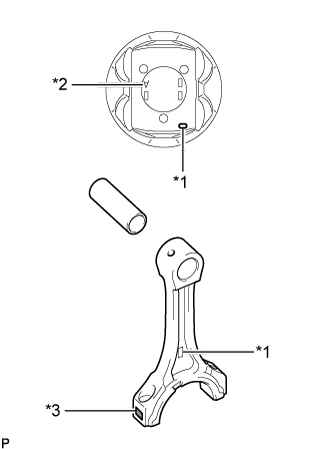
Check each mark on the piston and connecting rod.
| *1 | Front Mark |
| *2 | Position Pin Hole Inside Diameter Mark |
| *3 | Connecting Rod Bush Inside Diameter Mark |

Using a caliper gauge, measure the inside diameter of the piston pin hole.
- Standard Piston Pin Hole Inside Diameter:
Item Specified Condition Mark A 21.998 to 22.001 mm (0.86606 to 0.86618 in.) Mark B 22.001 to 22.004 mm (0.86618 to 0.86630 in.) Mark C 22.004 to 22.007 mm (0.86630 to 0.86642 in.)
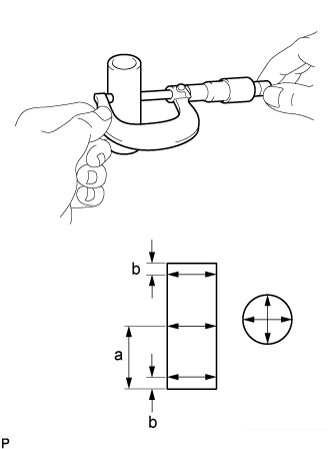
Using a micrometer, measure the piston pin diameter.
- Measurement Position:
Measurement Position Piston Pin Position a 28 mm (1.102 in.) from edge b 5 mm (0.197 in.) from edge
- Standard Piston Pin Diameter:
Item Specified Condition Mark A 21.998 to 22.001 mm (0.86606 to 0.86618 in.) Mark B 22.001 to 22.004 mm (0.86618 to 0.86630 in.) Mark C 22.004 to 22.007 mm (0.86630 to 0.86642 in.)
Using a caliper gauge, measure the inside diameter of the connecting rod bush.
- Standard Bush Inside Diameter:
Item Specified Condition Mark A 22.005 to 22.008 mm (0.86634 to 0.86645 in.) Mark B 22.008 to 22.011 mm (0.86645 to 0.86657 in.) Mark C 22.011 to 22.014 mm (0.86657 to 0.86669 in.)
Subtract the piston pin diameter measurement from the piston pin hole diameter measurement.
- Standard oil clearance:
- -0.002 to 0.004 mm (-0.0000787 to 0.000157 in.)
- Maximum oil clearance:
- 0.015 mm (0.000591 in.)
If the oil clearance is more than the maximum, replace the piston with pin sub-assembly.
Subtract the piston pin diameter measurement from the bush inside diameter measurement.
- Standard oil clearance:
- 0.005 to 0.011 mm (0.000197 to 0.000433 in.)
- Maximum oil clearance:
- 0.03 mm (0.00118 in.)
If the oil clearance is more than the maximum, replace the connecting rod sub-assembly. If necessary, replace the piston with pin sub-assembly.
| 9. INSPECT CONNECTING ROD SUB-ASSEMBLY |

Using a rod aligner and feeler gauge, check the connecting rod alignment.
Check for bend.
- Maximum bend:
- 0.05 mm (0.00197 in.) per 100 mm (3.94 in.)
If the bend is more than the maximum, replace the connecting rod sub-assembly.

Check for twist.
- Maximum twist:
- 0.15 mm (0.00591 in.) per 100 mm (3.94 in.)
If the twist is more than the maximum, replace the connecting rod sub-assembly.
| 10. INSPECT CRANKSHAFT |
Using a dial indicator, measure the runout at the center journal.
- Maximum circle runout:
- 0.06 mm (0.00236 in.)
If the circle runout is more than the maximum, replace the crankshaft.

Using a micrometer, measure the diameter of each main journal.
- Standard diameter:
- 66.988 to 67.000 mm (2.6373 to 2.6378 in.)
If the diameter is not as specified, check the oil clearance. If necessary, replace the crankshaft.
Check each main journal for taper and out-of-round as shown in the illustration.
- Maximum taper and out-of-round:
- 0.02 mm (0.000787 in.)
If the taper and out-of-round is more than the maximum, replace the crankshaft.

Using a micrometer, measure the diameter of each crank pin.
- Standard diameter:
- 52.982 to 53.000 mm (2.0859 to 2.0866 in.)
If the diameter is not as specified, check the oil clearance. If necessary, replace the crankshaft.
Check each crank pin for taper and out-of-round as shown in the illustration.
- Maximum taper and out-of-round:
- 0.02 mm (0.000787 in.)
If the taper and out-of-round is more than the maximum, replace the crankshaft.
| 11. INSPECT CRANKSHAFT OIL CLEARANCE |
Check each main journal and bearing for pitting and scratches.
If the journal or bearing is damaged, replace the bearing.
Install the crankshaft bearings and upper crankshaft thrust washers.
Clean each main journal and bearing.
Place the crankshaft on the cylinder block.
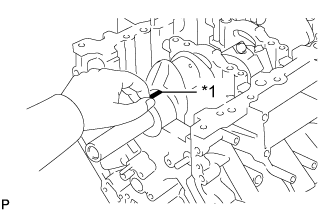
Lay a strip of Plastigage across each journal.
| *1 | Plastigage |
Install the crankshaft bearing caps ().
- NOTICE:
- Do not turn the crankshaft.
Remove the crankshaft bearing caps ().
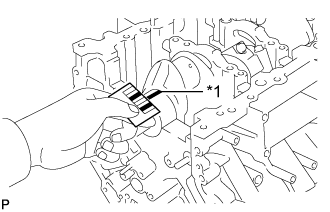
Measure the Plastigage at its widest point.
- Standard Oil Clearance:
Item Specified Condition No. 1 and No. 5 journals 0.017 to 0.030 mm (0.000669 to 0.00118 in.) Other journals 0.024 to 0.037 mm (0.000945 to 0.00146 in.)
- Maximum Oil Clearance:
Item Specified Condition No. 1 and No. 5 journals 0.050 mm (0.00197 in.) Other journals 0.060 mm (0.00236 in.)
| *1 | Plastigage |
If the oil clearance is more than the maximum, replace the bearings. If necessary, replace the crankshaft.
- HINT:
- If replacing a bearing, replace it with one that has the same number. If the number of the bearing cannot be determined, select the correct bearing by adding together the numbers imprinted on the cylinder block and crankshaft. Refer to the table below for the appropriate bearing number. There are 6 sizes of standard bearings. For the No. 1 and No. 5 position bearings, use bearings marked 4, 5, 6, 7, 8 and 9. For other bearings, use bearings marked 3, 4, 5, 6, 7 and 8.
| *1 | Cylinder Block Number Mark (A) | *2 | Crankshaft Number Mark (B) |
| *3 | Journal Bearing Number Mark | *4 | No. 1 and No. 5 Journal Bearings |
| *5 | No. 2, No. 3 and No. 4 Journal Bearings | *6 | No. 1 Journal |
| *7 | No. 2 Journal | *8 | No. 3 Journal |
| *9 | No. 4 Journal | *10 | No. 5 Journal |
- HINT:
- (Cylinder block journal diameter - crankshaft journal diameter - 5) X 1000 = A + B
A = Cylinder block number mark
B = Crankshaft number mark
- Standard Bearing Chart:
No. 1 and No. 5 Journals Item Number Mark (A) + (B) 00 to 02 03 to 05 06 to 08 09 to 11 12 to 14 15 to 17 18 to 20 21 to 23 24 to 26 27 to 28 Use bearing Upper 4 5 5 6 6 7 7 8 8 9 Lower 5 5 6 6 7 7 8 8 9 9
- Other Journals:
Item Number Mark (A) + (B) 00 to 02 03 to 05 06 to 08 09 to 11 12 to 14 15 to 17 18 to 20 21 to 23 24 to 26 27 to 28 Use bearing Upper 3 4 4 5 5 6 6 7 7 8 Lower 4 4 5 5 6 6 7 7 8 8
No. 1 and No. 5 journals
Cylinder block (A) "7" + Crankshaft (B) "6" = Total number 13 (Use upper bearing "6" and lower bearing "7")
Other journals
Cylinder block (A) "7" + Crankshaft (B) "6" = Total number 13 (Use upper bearing "5" and lower bearing "6")
- Standard Cylinder Block Crankshaft Journal Bore Diameter (A):
Item Specified Condition Mark 00 72.000 mm (2.83464 in.) Mark 01 72.001 mm (2.83469 in.) Mark 02 72.002 mm (2.83472 in.) Mark 03 72.003 mm (2.83476 in.) Mark 04 72.004 mm (2.83480 in.) Mark 05 72.005 mm (2.83484 in.) Mark 06 72.006 mm (2.83488 in.) Mark 07 72.007 mm (2.83492 in.) Mark 08 72.008 mm (2.83496 in.) Mark 09 72.009 mm (2.83500 in.) Mark 10 72.010 mm (2.83503 in.) Mark 11 72.011 mm (2.83508 in.) Mark 12 72.012 mm (2.83512 in.) Mark 13 72.013 mm (2.83516 in.) Mark 14 72.014 mm (2.83520 in.) Mark 15 72.015 mm (2.83524 in.) Mark 16 72.016 mm (2.83528 in.)
- Standard Crankshaft Journal Diameter (B):
Item Specified Condition Mark 00 67.000 mm (2.63780 in.) Mark 01 66.999 mm (2.63775 in.) Mark 02 66.998 mm (2.63771 in.) Mark 03 66.997 mm (2.63768 in.) Mark 04 66.996 mm (2.63763 in.) Mark 05 66.995 mm (2.63760 in.) Mark 06 66.994 mm (2.63756 in.) Mark 07 66.993 mm (2.63751 in.) Mark 08 66.992 mm (2.63748 in.) Mark 09 66.991 mm (2.63744 in.) Mark 10 66.990 mm (2.63740 in.) Mark 11 66.989 mm (2.63736 in.) Mark 12 66.988 mm (2.63732 in.)
- Standard Bearing Center Wall Thickness:
No. 1 and No. 5 Journals Upper Bearing Lower Bearing Item Specified Condition Item Specified Condition Mark 4 2.501 to 2.504 mm (0.0985 to 0.0986 in.) Mark 5 2.488 to 2.491 mm (0.0980 to 0.0981 in.) Mark 5 2.504 to 2.507 mm (0.0986 to 0.0987 in.) Mark 6 2.491 to 2.494 mm (0.0981 to 0.0982 in.) Mark 6 2.507 to 2.510 mm (0.0987 to 0.0988 in.) Mark 7 2.494 to 2.497 mm (0.0982 to 0.0983 in.) Mark 7 2.510 to 2.513 mm (0.0988 to 0.0989 in.) Mark 8 2.497 to 2.500 mm (0.0983 to 0.0984 in.) Mark 8 2.513 to 2.516 mm (0.0989 to 0.0991 in.) Mark 9 2.500 to 2.503 mm (0.0984 to 0.0985 in.) Mark 9 2.516 to 2.519 mm (0.0991 to 0.0992 in.) - -
- Other Journals:
Upper Bearing Lower Bearing Item Specified Condition Item Specified Condition Mark 3 2.482 to 2.485 mm (0.0977 to 0.0978 in.) Mark 4 2.501 to 2.504 mm (0.0985 to 0.0986 in.) Mark 4 2.485 to 2.488 mm (0.0978 to 0.0980 in.) Mark 5 2.504 to 2.507 mm (0.0986 to 0.0987 in.) Mark 5 2.488 to 2.491 mm (0.0980 to 0.0981 in.) Mark 6 2.507 to 2.510 mm (0.0987 to 0.0988 in.) Mark 6 2.491 to 2.494 mm (0.0981 to 0.0982 in.) Mark 7 2.510 to 2.513 mm (0.0988 to 0.0989 in.) Mark 7 2.494 to 2.497 mm (0.0982 to 0.0983 in.) Mark 8 2.513 to 2.516 mm (0.0989 to 0.0991 in.) Mark 8 2.497 to 2.500 mm (0.0983 to 0.0984 in.) - -
Completely remove the Plastigage.
Perform the inspection above for each journal.
| 12. INSPECT CONNECTING ROD BOLT |

Using a vernier caliper, measure the tension portion diameter of the bolt.
- Standard diameter:
- 8.5 to 8.6 mm (0.335 to 0.339 in.)
- Minimum diameter:
- 8.3 mm (0.327 in.)
| *1 | Tension Portion |
If the diameter is less than the minimum, replace the connecting rod bolt.
| 13. INSPECT CRANKSHAFT BEARING CAP SET BOLT |
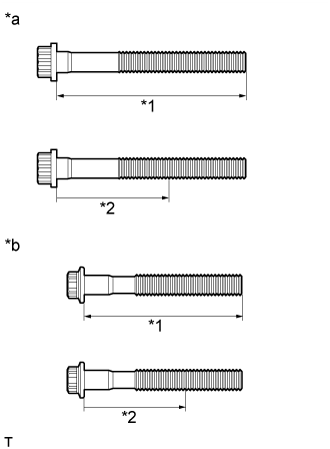
Using a vernier caliper, measure the length of the crankshaft bearing cap bolt from the seat to the end.
- Standard Bolt Length:
Item Specified Condition Bolt A 90.3 to 91.7 mm (3.56 to 3.61 in.) Bolt B 78.8 to 80.2 mm (3.10 to 3.16 in.)
- Maximum Bolt Length:
Item Specified Condition Bolt A 92.7 mm (3.65 in.) Bolt B 81.2 mm (3.20 in.)
| *1 | Measurement Length |
| *2 | Distance |
| *a | Bolt A |
| *b | Bolt B |
If the length is more than the maximum, replace the crankshaft bearing cap set bolt.
Using a vernier caliper, measure the diameter of the elongated threads around the point indicated in the illustration.
- Distance:
- 57.5 mm (2.26 in.)
- Standard Diameter:
Item Specified Condition Bolt A 10.5 to 11.0 mm (0.413 to 0.433 in.) Bolt B 9.5 to 10.0 mm (0.374 to 0.394 in.)
- Minimum Diameter:
Item Specified Condition Bolt A 10.4 mm (0.409 in.) Bolt B 9.4 mm (0.370 in.)
If the diameter is less than the minimum, replace the crankshaft bearing cap set bolt.
- HINT:
- If a visual check reveals no excessively thin areas, check the area of the bolt around the point indicated in the illustration and find the area that has the smallest diameter.
| 14. INSPECT NO. 1 OIL NOZZLE SUB-ASSEMBLY |

Push the check valve with a pin to check if it is stuck.
If stuck, replace the No. 1 oil nozzle.
Push the check valve with a pin to check if it moves smoothly.
If it does not move smoothly, clean or replace the No. 1 oil nozzle sub-assembly.
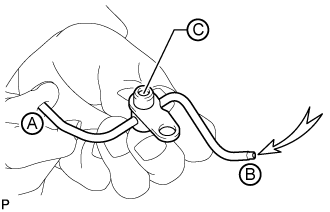
While covering A, blow air into B. Check that air does not leak through C. Perform the check again while covering B and blowing air into A.
If air leaks, clean or replace the No. 1 oil nozzle sub-assembly.

Push the check valve while covering A and blow air into B. Check that air passes through C. Perform the check again while covering B, pushing the check valve and blowing air into A.
If air does not pass through C, clean or replace the No. 1 oil nozzle sub-assembly.
